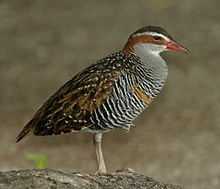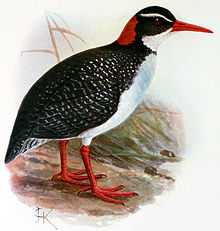Tahiti rail
| Tahiti rail | |
|---|---|
 | |
| 1773 watercolour by Georg Forster | |
| Conservation status | |
| Scientific classification | |
| Kingdom: | Animalia |
| Phylum: | Chordata |
| Class: | Aves |
| Order: | Gruiformes |
| Family: | Rallidae |
| Genus: | Gallirallus |
| Species: | G. pacificus |
| Binomial name | |
| Gallirallus pacificus (Gmelin, 1789) | |
| | |
| Location of Tahiti and Mehetia | |
| Synonyms | |
| |
The Tahiti rail (Gallirallus pacificus) or Tahitian red-billed rail is a poorly known extinct species of rail.
Taxonomy

It once occurred on Tahiti, where, apparently on the second voyage of James Cook in 1773, one was acquired and described by Johann Reinhold Forster as well as painted by his son Georg. What became of Forster's specimen is not known. This flightless species was probably derived from the ubiquitous buff-banded rail stock. The Tahitian name was transcribed as ebōnā or ōmnā (see also below).[2]
Due to a major taxonomic mix-up, the name Rallus ecaudatus was commonly used in the mid-late 20th century to refer to this bird. This is, however, in error, as that taxon is an extant subspecies of the buff-banded rail, today known as Gallirallus philippensis ecaudatus. Also, at least once, the Tahitian bird has been referred to by the scientific name of the Samoan wood rail, Gallinula pacifica, in a major scientific work.[3][4][5][6]
Description

Forster's description follows below:
Black with white spots or bars; abdomen, throat, and eyebrow white; hind neck ferruginous; breast grey; bill blood-red; iris red. Bill straight, compressed, narrowed at the top, thicker at the base, and blood-red. The mandibles subequal, pointed; the upper slightlv curved, with the tip pale fuscous; gape medium. Nostrils almost at the base of bill, linear. Eyes placed above the gape of the mouth. Iris blood-red. Feet four-toed, split, built for running, flesh coloured. Femora semi-bare, slender, of medium length.Tibiae slightly compressed, shorter than the femora. Four toes, slender, of which three point forward (are front toes). The middle one almost as long as the Tibia, the side ones 'of equal length shorter, the back one short, raised from the ground. Nails short, small, slightly incurved, pointed, and light coloured. Head oval, slightly depressed, fuscous. A superciliary line from bill to occiput whitish. Throat white. Hindneck ferruginous. Neck very short. Back and rump black, sparsely dotted with minute white dots. Breast bluish grey. Abdomen, crissum, and loins white. Wings short, wholly black, variegated with broken white bands. Remiges short. Rectrices extremely short, black spotted with white, hardly to be distinguished from the coverts.[4]
Walter Rothschild commissioned John Gerrard Keulemans to illustrate the bird for his 1907 book, based on Forster's then unpublished drawing. In the bird's entry, Rothschild noted that the legs had been painted too bright right, when they should instead have been flesh-coloured.[4]
Extinction
Little can be said about the species' disappearance. As with most extinct Pacific rails still encountered alive by scientists, introduced predators are the most likely suspects for its extinction. It may have become extinct soon after Cook's visit, but the bird was still reported to have existed until recently in 1844. Considering that the bird was probably very cryptic, this may have been true. Even more astounding is the claim by locals that it was found until approximately the 1920s on the islet of Mehetia, although this seems hardly true, since the distance between Tahiti and Mehetia is about 100 km and the Tahiti rail was, as mentioned above, flightless. The native name tevea seems to refer to the Mehetia bird. If indeed a rail existed on Mehetia, it is more probable that it was a closely related but distinct species. Considering that Mehetia was not permanently inhabited and thus probably free from predators, it is even quite likely that the late extinction date of that bird is correct. Whether a distinct species could evolve and persist on tiny (2.3 km²) Mehetia is less certain, especially as the island seems to have been subject to heavy volcanic activity in the last 2000 years; an alternative explanation could be that birds were translocated from Tahiti by Polynesian woodcarvers for provisioning during their stays on Mehetia.[7]
References
- ↑ BirdLife International (2012). "Gallirallus pacificus". IUCN Red List of Threatened Species. Version 2013.2. International Union for Conservation of Nature. Retrieved 26 November 2013.
- ↑ Gmelin, Johann Friedrich (1879): [Description of Gallirallus pacificus]. In: Systema Naturae (13th edition) 1, part 2: 717.
- ↑ Olson, S. (1977). A synopsis on the fossil Rallidae In: Ripley, S. D.: Rails of the World – A Monograph of the Family Rallidae. Boston: Codline. ISBN 978-0-87474-804-8.
- ↑ 4.0 4.1 4.2 Rothschild, W. (1907). Extinct Birds. London: Hutchinson & Co. p. 123.
- ↑ Hume, J. P.; Walters, M. (2012). Extinct Birds. London: A & C Black. pp. 92–93. ISBN 1-4081-5725-X.
- ↑ Fuller, E. (2001). Extinct Birds (revised ed.). New York: Comstock. pp. 128–130. ISBN 978-0-8014-3954-4.
- ↑ Greenway, J. C. (1967). Extinct and Vanishing Birds of the World. New York: American Committee for International Wild Life Protection 13. pp. 218–219. ISBN 0486218694.
